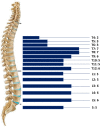Osseous cystic echinococcosis: A case series study at a referral unit in Spain
- PMID: 30779741
- PMCID: PMC6396934
- DOI: 10.1371/journal.pntd.0007006
Osseous cystic echinococcosis: A case series study at a referral unit in Spain
Abstract
Background: Cystic echinococcosis (CE) is present in all continents, except for the Antarctica. Characteristically, CE lesions are found in the liver and the lungs, but virtually any part of the body may be affected (the spleen, kidneys, heart, central nervous system, bones, among others). It is estimated that the incidence of bone involvement in CE is 0.5% to 4%.
Methodology: A retrospective study was performed of patients with osseous CE treated at the National Reference Unit of Tropical Diseases of the Ramon y Cajal Hospital, Madrid, Spain, between 1989 and December 2017. Epidemiological, clinical, diagnostic and therapeutic data of patients with long-term follow-up were collected.
Main findings: During the study period, of the 104 patients with CE, 27 exhibited bone involvement (26%). The bones most frequently affected were the spine, followed by the ribs, pelvis, femur, tibia and the scapula. The most common symptom was pain followed by medullar syndrome and pathologic fracture. In total, 81.5% of patients underwent surgery for osseous CE at least once. As many as 96% received albendazol either in (mostly long-term) monotherapy or in combination with praziquantel.
Conclusions: The diagnosis and management of osseous CE is challenging. In many cases osseous CE should be considered a chronic disease and should be managed on a case-by-case basis. Lifelong follow-up should be performed for potential recurrence and sequels.
Conflict of interest statement
The authors have declared that no competing interest exist.
Figures
References
-
- Manson’s Tropical Diseases Twenty-Third Edition, Elsevier SAUNDERS; 2014. Editors Farrar Jeremy Hotez Peter J. Junghanss Thomas Kang Gagandeep Lalloo David White Nicholas J. Chapter 56, Echinococcosis; p. 795–816.
-
- Eckert J, Schantz PM, Gasser RB, et al. Geographic distribution and prevalence In: Eckert J, Gemmell MA, Meslin FX, et al. Editors WHO/OIE Manual on Echinococcosis in Humans and Animals: a Public Health Problem of Global Concern. Paris: WHO; 2001. p. 100–34.
MeSH terms
Substances
LinkOut - more resources
Full Text Sources
Medical
Research Materials



